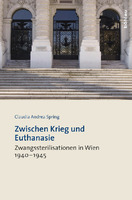Zwischen Krieg und Euthanasie
Zwangssterilisationen in Wien 1940–1945
Author(s)
Spring, Claudia Andrea
Collection
Austrian Science Fund (FWF)Language
GermanAbstract
This publication describes in detail the preparation and realization of the forcibly sterilization of numerous women and men Vienna from 1940 to 1945.
These forced sterilizations of individuals, being categorized as 'hereditary ill', were based on the 'Law for the Prevention of Genetically Diseased Offspring' (GzVeN). In Nazi Germany it took effect in January 1934, and until the outbreak of the war, when most of the court-proceedings had already ended, 300.000 women and men, had been forcibly sterilized. In January 1940 the law was implemented in the 'Ostmark', and at least 6.000 women and men had been forcibly sterilized during the war. In Vienna, the then second-largest city of the 'German Reich' 1.203 court-decisions in favour of a forcibly sterilization could be traced-back.
These court-files of the 'Viennese Hereditary Health Court' (Erbgesundheitsgericht) became accessible for research only recently. The quantitative and qualitative analysis indicates three parameters for the implementation of the GzVeN in Vienna: First of all, the reduction of lawsuits to 'urgent' cases, i.e. persons of a 'particularly great danger of procreation'; secondly, the personal and structural restrictions resulting from war; and thirdly, the Nazi Euthanasia: Different from Nazi Germany the forced sterilizations had not been preceding the murder of disabled persons, but were rather implemented in the same period of time. Several doctors in Vienna were responsible for both, forced sterilizations and murder.
Both judges and doctors of the 'Viennese Hereditary Health Court' were keen to contribute to the radical efforts to create the visional 'healthy national body' by fulfilling the GzVeN independent of the above mentioned parameters: they implemented a National Socialist tort-law, which included a surgical intervention with severe and lifelong psychical and physical consequences - against the will of the people who were affected.
After the end of the war, the judges and doctors did not have to take any kind of responsibility for their decisions to sterilize people forcibly. This was not surprising, taking into account that the categorization of persons due to their 'value of hereditage' ('Erbwert') continued: Firstly, the then-chancellor Renner announced to pass a similar law when the GzVeN was repealed in Mai 1945; secondly, the forcibly sterilized women and men were partly acknowledged only in 1995 as victims of Nazi-persecution and fully acknowledged only 2005; and thirdly, until to the present, women, being categorized as 'disabled', are still sterilized without their knowledge and therefore without their consent. However, this bodily injury does not carry a penalty, since there is no contradiction to the so called 'good manners' ('gute Sitten'), incorporated in the criminal law. In dieser Publikation werden Vorbereitung und Durchführung der Zwangssterilisation von als ‚erbkrank' kategorisierten Frauen und Männern in Wien zwischen 1940 und 1945 detailliert beschrieben.
Das den Zwangssterilisationen zugrunde liegende ‚Gesetz zur Verhütung erbkranken Nachwuchses' (GzVeN) trat in der ‚Ostmark' im Jänner 1940 in Kraft, sechs Jahre später als in NS-Deutschland, wo bereits 300.000 Menschen, etwa gleich viele Frauen wie Männer zwangssterilisiert worden waren. Während es dort nach Kriegsbeginn kaum noch zu Verfahren kam, wurden in der ‚Ostmark' mindestens 6.000 Frauen und Männer bis Kriegsende zwangssterilisiert. Für Wien, der nach dem ‚Anschluss' zweitgrößten Stadt des Deutschen Reiches, sind 1.203 Gerichtsbeschlüsse zur Zwangssterilisation rekonstruierbar.
Die quantitative und qualitative Auswertung der erst seit kurzem für die Forschung zugänglichen Verfahrensakten des Erbgesundheitsgerichts und des Erbgesundheitsobergerichts Wien zeigt, dass drei Rahmenbedingungen den Vollzug des GzVeN prägten: erstens die im Herbst 1939 vorgenommenen Einschränkungen des GzVeN, wonach Ärzte nur noch bei ‚besonders großer Fortpflanzungsgefahr' der als ‚erbkrank' kategorisierten Frauen und Männer ein Verfahren beim Erbgesundheitsgericht einbringen sollten, zweitens der Krieg mit allen dadurch bedingten personellen und organisatorischen Einschränkungen und drittens die NS-Euthanasie: Anders als in NS-Deutschland waren Zwangssterilisationen nicht die Vorstufe dazu - die Entscheidung über Zwangssterilisation oder Tötung verlief von Anfang an parallel und einige Ärzte in Wien waren für beides verantwortlich.
Die Auswertung verdeutlicht weiters, dass Richter und ärztliche Beisitzer der Wiener Erbgesundheitsgerichtsbarkeit willige Vollstrecker waren beim radikalen Versuch der Verwirklichung der Vision eines ‚gesunden Volkskörpers', indem sie das GzVeN unbeirrt von sonstigen Rahmenbedingungen vollzogen: ein nationalsozialistisches Unrechtsgesetz, das einen körperlichen Eingriff mit schwerwiegenden und lebenslangen Folgen gegen den Willen der Betroffenen vorsah.
Nach Kriegsende mussten sich Richter und Ärzte nicht für ihre Mitverantwortung an den Zwangssterilisationen verantworten. Dies verwundert nicht, dauert doch das ‚Denken in Erbwerten' bis heute ungebrochen an: Das GzVeN wurde zwar im Mai 1945 aufgehoben, doch kündigte Staatskanzler Renner gleichzeitig ein ähnliches Gesetz an; zwangssterilisierte Frauen und Männer wurden erst 1995 bedingt und erst 2005 uneingeschränkt als NS-Opfer anerkannt; und bis in die Gegenwart werden vor allem als behindert definierte Frauen ohne ihr Wissen und ohne ihre Zustimmung sterilisiert, ohne dass diese Eingriffe strafrechtliche Konsequenzen nach sich zögen - widersprechen sie doch nicht dem dazu im Strafrecht verankerten Terminus der ‚guten Sitten'.
Keywords
National socialism; Forced Sterilizations; Gender; Eugenics; Austria; Medicine; Beisitzer; Beschwerde (deutsches Recht); Erbgesundheitsgericht; Richter; Wien; ZwangssterilisationDOI
10.26530/oapen_437180OCN
995240191Publisher
BrillPublisher website
https://brill.com/Publication date and place
2009Grantor
Imprint
BöhlauClassification
Society and Social Sciences


 Download
Download